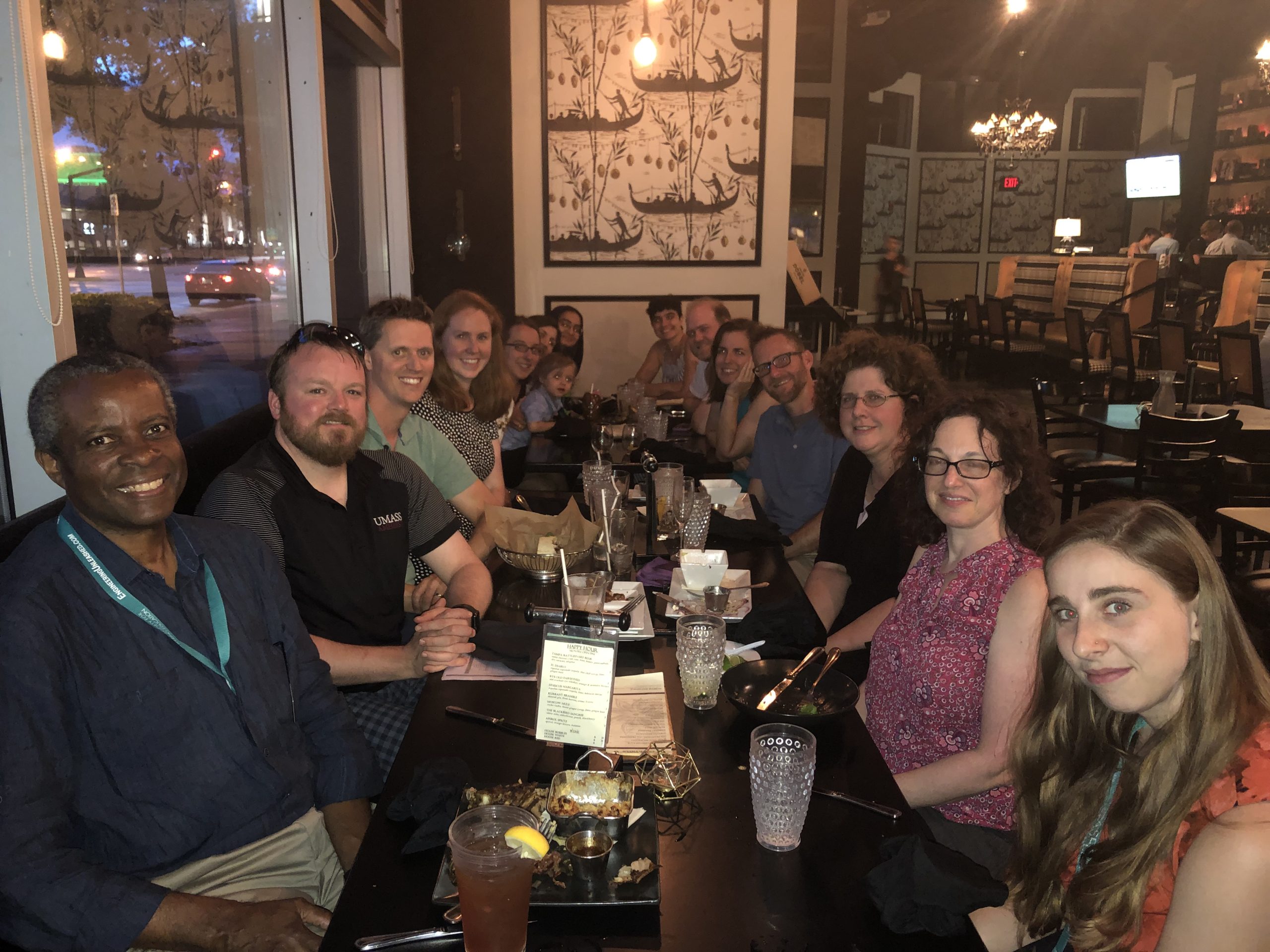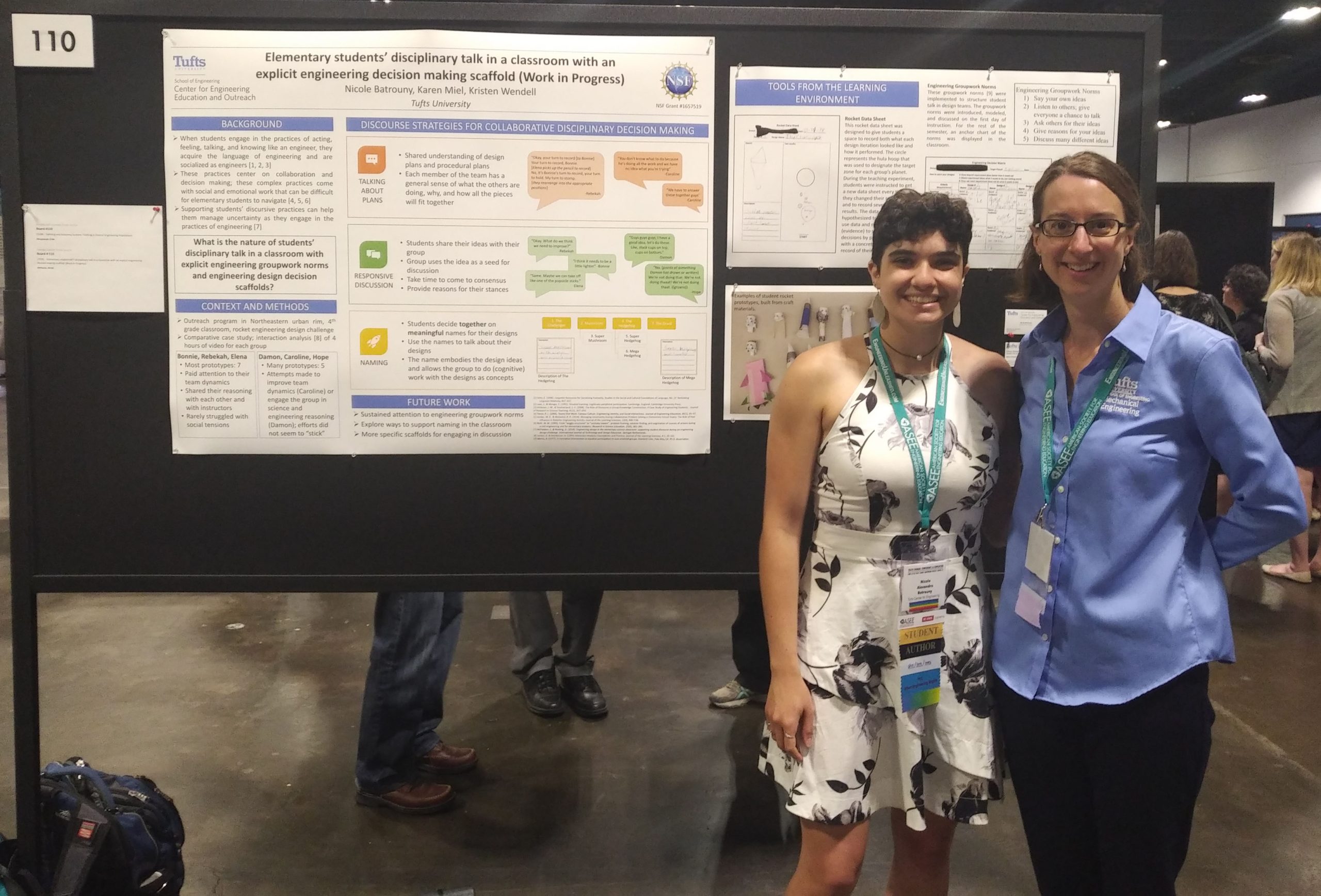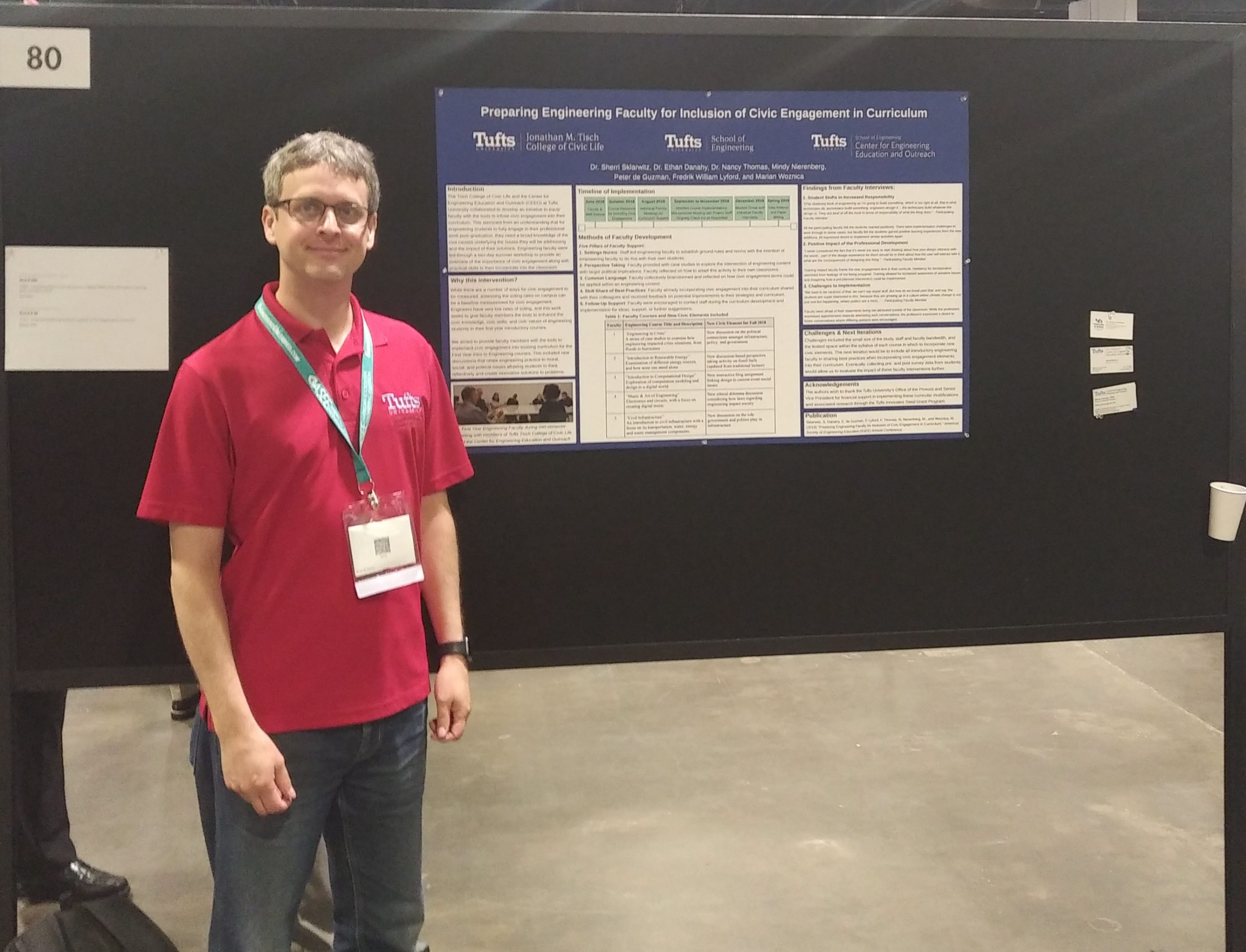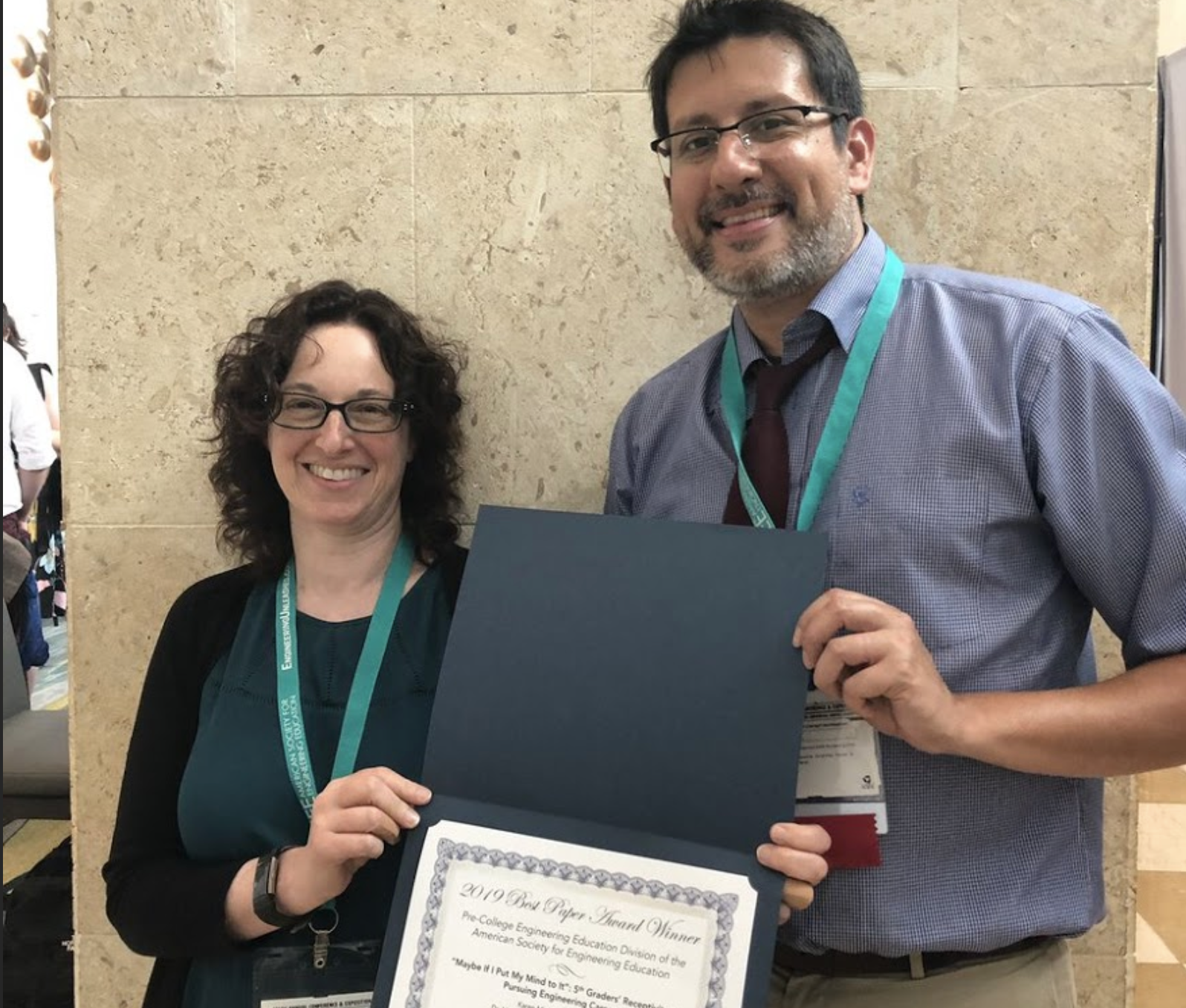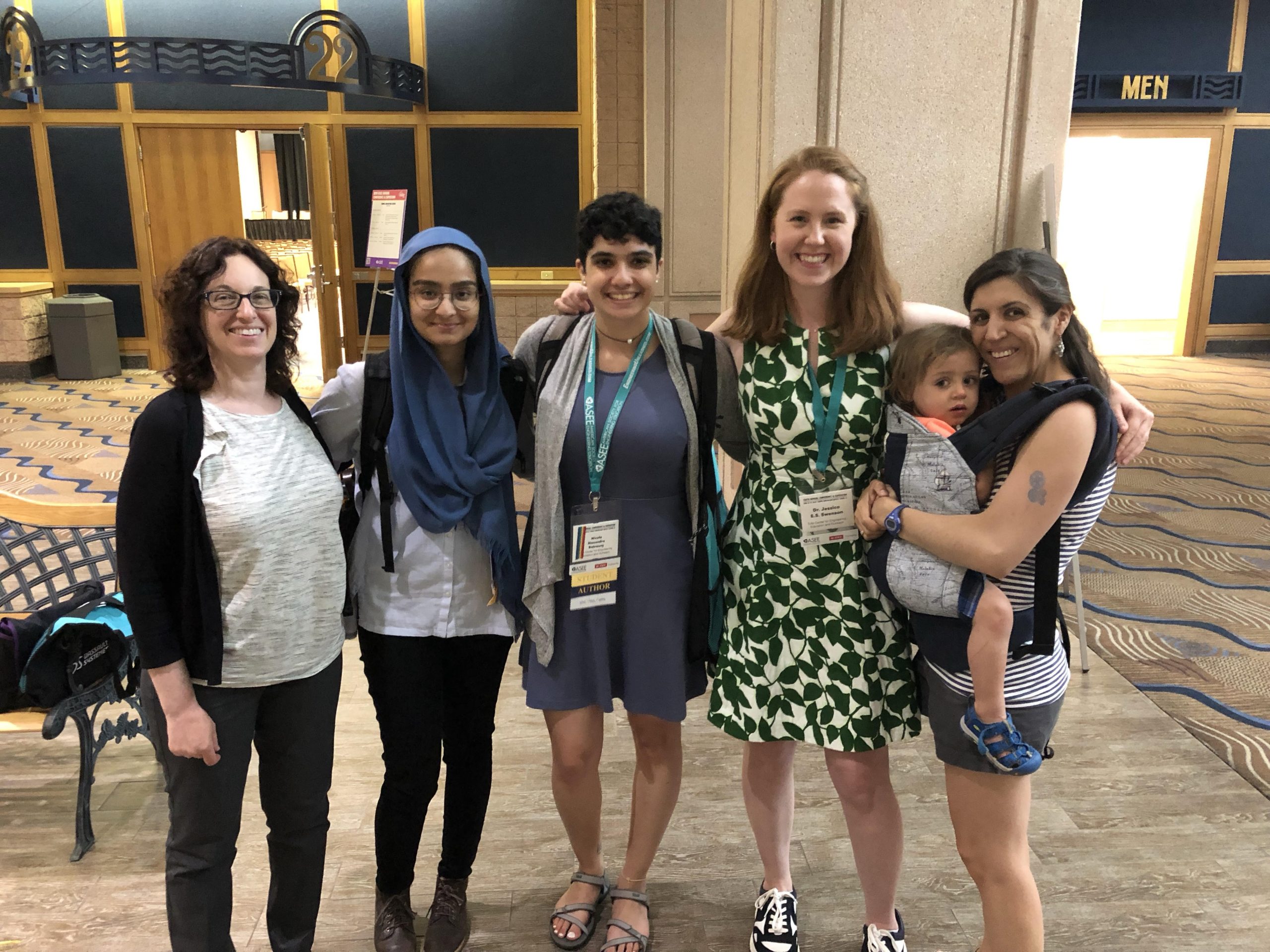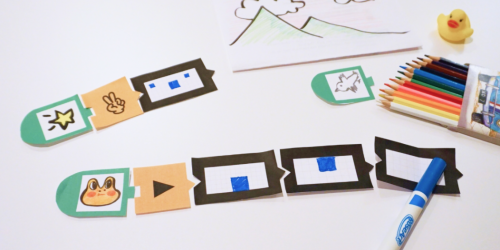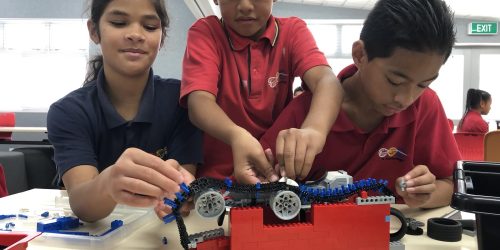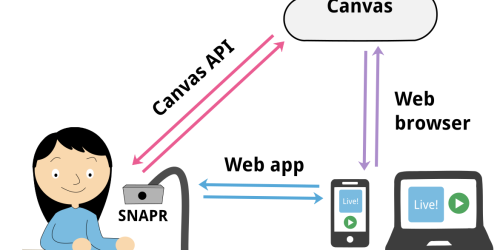Tufts Center for Engineering Education and Outreach (CEEO) graduate students and faculty attended the 2019 Annual American Society for Engineering Education (ASEE) Conference this June in Tampa, FL. We were excited to have eleven conference papers accepted this year. Congratulations to Karen Miel for winning the Best Paper Award in the Pre-College Division. Below are the papers that were presented at ASEE this year.
- Elementary Students’ Disciplinary Talk in a Classroom with an Explicit Engineering Decision-making Scaffold (Work in Progress) Nicole Batrouny, Karen Miel, and Kristen Wendell
- Preparing Engineering Faculty for Inclusion of Civic Engagement in Curriculum Sherri Sklarwitz, Ethan Danahy, Peter de Guzman, Fredrik Lyford, Mindy Nierenberg, Nancy Thomas, Marian Woznica
-
“Maybe if I put my mind to it”: 5th Graders’ Receptivity to Pursuing Engineering Careers (Fundamental) 2019 Best Paper Award Winner, Pre-College Engineering Education Division Karen Miel, Merredith Portsmore, Emily Fuller, Kelli Paul, Euisuk Sung, and Adam Maltese
- Development of a Create-a-LEGO-Engineer Activity to Examine Students’ Engineering Identity (Work in Progress) Kelli Paul, Euisuk Sung, Adam Maltese, Karen Miel, and Merredith Portsmore
- Development of an Engineering Identity and Career Aspirations Survey for Use with Elementary Students (Work in Progress)
Kelli Paul, Adam Maltese, Karen Miel, Merredith Portsmore, and Euisuk Sung - Exploring the Impact of University Engineering Role Models on Elementary Students (NSF ITEST Project) Merredith Portsmore, Adam Maltese, Karen Miel, and Kelli Paul
- Engaging Teachers in Authentic Engineering Design Tasks to Refine their Disciplinary Understandings Merredith Portsmore, Jessica Watkins, and Rebecca Swanson
- Elementary Students Navigating the Demands of Giving Engineering Design Peer Feedback (Fundamental) Fatima Rahman, Chelsea Andrews, Kristen Wendell, Nicole Batrouny, and Tejaswini Dalvi
- Early Career Elementary Teachers’ Evolving Choices for Incorporating Engineering into Their Classroom Jessica Swenson and Kristen Wendell
- Transformations in Elementary Teachers’ Pedagogical Reasoning: Studying Teacher Learning in an Online Graduate Program in Engineering Education
Jessica Watkins, Merredith Portsmore, and Rebecca Swanson - Learning Assistant “Noticing” in Undergraduate Engineering Science Courses (Work in Progress) Kristen Wendell, Douglas Matson, Hernán Gallegos, and Luisa Chiesa
Elementary Students’ Disciplinary Talk in a Classroom with an Explicit Engineering Decision-making Scaffold (Work in Progress)
Nicole Batrouny, Karen Miel, and Kristen Wendell
While engineering grows as a part of elementary education, important questions arise about the skills and practices we ask of students. Both collaboration and decision making are complex and critical to the engineering design process, but come with social and emotional work that can be difficult for elementary students to navigate. Productive engagement in collaborative teams has been seen to be highly variable; for some teams, interpersonal conflicts move the design process forward, while for others they stall the process. In this work in progress, we are investigating the research question, what is the nature of students’ disciplinary talk during scaffolded decision making?
We explore this research question via a case study of one student group in a 4th-grade classroom enrolled in an outreach program run by a private university in a Northeastern city. This program sends pairs of university students into local elementary schools to facilitate engineering in the classroom for one hour per week. This is the only engineering instruction the elementary students receive and the engineering curriculum is planned by the university students. For the implementation examined in this study, the curriculum was designed by two researchers to scaffold collaborative groupwork and decision making. The instruction was provided by an undergraduate and one of the researchers, a graduate student.
The scaffolds designed for this semester of outreach include a set of groupwork norms and a decision matrix. The groupwork norms were introduced on the first day of instruction; the instructors read them aloud, proposed groupwork scenarios to facilitate a whole class discussion about whether or not the norms were followed and how the students could act to follow the norms, and provided time for students to practice the norms in their engineering design groups for the first project. For the rest of the semester, an anchor chart of the norms was displayed in the classroom and referenced to encourage consensus. The researchers designed the decision matrix scaffold to encourage design decisions between multiple prototypes based on problem criteria and test results. Instructors modeled the use of this decision matrix on the third day of instruction, and students utilized the matrix in both design projects of the semester.
Data sources for this descriptive study include students’ written artifacts, photos of their design constructions, and video records of whole-class and team discourse. We employ qualitative case study and microethnographic analysis techniques to explore the influence of the intentional discourse scaffolds on students’ collaborative and decision-making practices. Our analysis allowed us to characterize the linguistic resources (including the decision matrix) that the students used to complete four social acts during decision making: design evaluation, disagreeing with a teammate, arguing for a novel idea, and sympathizing with a design. This research has implications for the design of instructional scaffolds for engineering curricula at the elementary school level, whether taking place in an outreach program or in regular classroom instruction.
Preparing Engineering Faculty for Inclusion of Civic Engagement in Curriculum
Sherri Sklarwitz, Ethan Danahy, Peter de Guzman, Fredrik Lyford, Mindy Nierenberg, Nancy Thomas, Marian Woznica
This paper rests on the premise that political discussion and thinking around civic engagement is germane to the work that engineers do, and critical for faculty to incorporate into classroom spaces. The study presented here explores a partnership at Tufts University between the Jonathan M. Tisch College of Civic Life (Tisch College), the School of Engineering (SOE), and the Center for Engineering Education and Outreach (CEEO) to implement engineering faculty training and supports to assist instructors with infusing civic education into several foundational courses. The intervention aimed to provide faculty members with the tools to implement civic engagement into existing curriculum for a collection of first year intro to engineering courses, and to support faculty to think broadly about the role civic engagement already plays in the courses they are teaching. This paper (1) details the faculty professional development and supports provided before and during the semester as professors implemented new civic engagement curricular modifications. Then, based on a qualitative analysis of interview data from the participating faculty, it (2) highlights the faculty-identified successes and challenges to including civic topics in engineering content courses and (3) explores the levels to which the professional development as designed and implemented was able to appropriately prepare this cohort of engineering faculty for the inclusion of civic engagement in their courses. It also (4) details the future modifications and changes the authors propose based on these findings, and (5) discusses suggestions for how the program can be replicated and scaled (for instance, internally at Tufts University to all first-year courses and other faculty within the School of Engineering).
“Maybe if I put my mind to it”: 5th Graders’ Receptivity to Pursuing Engineering Careers (Fundamental)
2019 Best Paper Award Winner, Pre-College Engineering Education Division
Karen Miel, Merredith Portsmore, Emily Fuller, Kelli Paul, Euisuk Sung, and Adam Maltese
As educators strive to broaden representation in engineering, it is important to take into account how youth perceive themselves in relation to engineering careers. Youth as young as ten years of age are assessing the appeal and achievability of engineering as a career. This study explores preadolescents’ perceptions of the desirability of engineering careers and the self-assessed characteristics which impact students’ interest in engineering. In particular, this work unpacks what attracts elementary students to engineering careers and what these students believe it takes to be an engineer. Drawing from a set of 56 student interviews, this work addresses the research question In what ways are elementary school students thinking about careers in engineering? Existing research indicates that students’ interest in engineering careers declines as students enter middle school; this study contributes to understanding influences on students’ interests when they are on the cusp of deciding whether to pursue engineering study and careers.
As part of a study of a university-led engineering education outreach program in elementary classrooms, 5th grade students participated in 15- to 30-minute semi-structured interviews near the end of the academic year. Participants represented four classrooms in two suburban schools in the northeastern United States that had each engaged in 16-18 weeks of hands-on engineering activities led by undergraduate engineering students. Interviews focused on the students’ experiences with engineering and the engineering intervention, students’ role models, and students’ career aspirations. We utilized open coding to analyze the interviews and identified the keywords and themes that students used to describe why an engineering career would be appealing or unappealing and possible or impossible for them. Two themes characterized the interview data; these students’ receptivity to pursuing engineering careers appeared to be mediated by conceptions of engineering careers as involving skill (in idea generation or in creation of technology) or desire (the will to do engineering).
This paper utilizes interview data to attend to students’ perspectives and expand our understanding of barriers and gateways to student interest in engineering study and careers. It identifies a group of students, not previously identified in the literature, who see engineering as a possible career, but not as a compelling aspiration. It also discusses the implications of the findings for teaching engineering with an eye on the messages conveyed about the nature of engineering practices, the characteristics of engineers, and how students’ interests intersect with engineering careers
Development of a Create-a-LEGO-Engineer Activity to Examine Students’ Engineering Identity (Work in Progress)
Kelli Paul, Euisuk Sung, Adam Maltese, Karen Miel, and Merredith Portsmore
This paper describes the development of a Create-a-LEGO-Engineer (CALE) activity which was created as an alternative to the Draw-a-Scientist (DAST) and Draw-an-Engineer Tests (DAET). While the DAST and DAET examine students’ (mis)conceptions of scientists and engineers, they provide limited information about whether students can envision themselves as scientists or engineers now or in the future. We drew from the LEGO Serious Play (LSP) method which is grounded on the premise that hands-on learning results in a deeper understanding of the world and oneself in it. The LSP method is a process used to enhance innovation and business development, and it involves adults building metaphorical representations of their identity using LEGO bricks. We adapted this process for use with elementary students (3rd-5th grade) in a specific context, namely students are asked to build themselves as engineers and a scene depicting what they would be doing as an engineer. LEGO bricks were chosen as they are familiar to most students, are easy to use even without prior experience, and require no special skills or artistic abilities. The activity allows us to explore students’ creations of physical representations of themselves as engineers, including issues related to gender and physical characteristics (e.g., skin color, hair color and style), all of which students can customize using a variety of LEGO options. Students are provided with a variety of LEGO person pieces in order to try and build a representation of themselves using LEGO. Additionally, a wide variety of LEGO brick pieces were provided in order to allow for numerous ways in which students might represent engineers doing engineering work. Students were asked to imagine themselves as engineers and then to create their LEGO engineer. Next, on a notecard, they described the type of work their LEGO engineer would be doing, at which point they were then asked to create this scene using LEGO bricks. Finally, after completing their creations, students reflected on the meaning of what they built and verbally described their creation and the choices they made. While these reflections provide additional insight into students’ beliefs about who can be an engineer and what engineers do, they also provide students an opportunity to imagine and see themselves in the role of an engineer. This activity was developed within the context of a multi-year, NSF-funded research project examining the dynamics between undergraduate outreach providers and elementary students to understand the impact of the program on students’ engineering identity and career aspirations. This paper will describe the development of the activity as well as preliminary findings from pilot testing and use with elementary students participating in the overall research project. Potential implications and limitations will be described.
Development of an Engineering Identity and Career Aspirations Survey for Use with Elementary Students (Work in Progress)
Kelli Paul, Adam Maltese, Karen Miel, Merredith Portsmore, and Euisuk Sung
Interest in science, technology, engineering, and mathematics (STEM) begins as early as elementary and middle school. As youth enter adolescence, they begin to shape their personal identities and start making decisions about who they are and could be in the future. Students form their career aspirations and interests related to STEM in elementary school, long before they choose STEM coursework in high school or college. Much of the literature examines either science or STEM identity and career aspirations without separating out individual sub-disciplines. Therefore, the purpose of this paper is to describe the development of a survey instrument to specifically measure engineering identity and career aspirations in adolescents and preadolescents. When possible, we utilized existing measures of STEM identity and career aspirations, adapting them when necessary to the elementary school level and to fit the engineering context. The instrument was developed within the context of a multi-year, NSF-funded research project examining the dynamics between undergraduate outreach providers and elementary students to understand the impact of the program on students’ engineering identity and career aspirations. Three phases of survey development were conducted that involved 492 elementary students from diverse communities in the United States. Three sets of items were developed and/or adapted throughout the four phases. The first set of items assessed Engineering Identity. Recent research suggests that identity consists of three components: recognition, interest, and performance/competence. Items assessing each of these constructs were included in the survey. The second and third sets of items reflected Career Interests and Aspirations. Because elementary and middle school students often have a limited or nascent awareness of what engineers do or misconceptions about what a job in science or engineering entails, it is problematic to measure their engineering identity or career aspirations by directly asking them whether they want to be a scientist/engineer or by using a checklist of broad career categories. Therefore, similar to other researchers, the second set of items assessed the types of activities that students are interested in doing as part of a future career, including both non-STEM and STEM (general and engineering-specific) activities. These items were created by the research team or adapted from activity lists used in existing research. The third set of items drew from career counseling measures relying on Holland’s Career Codes. We adapted the format of these instruments by asking students to choose the activity they liked the most from a list of six activities that reflected each of the codes rather than responding to their interest about each activity. Preliminary findings for each set of items will be discussed. Results from the survey contribute to our understanding of engineering identities and career aspirations in preadolescent and adolescent youth. However, our instrument has the potential for broader application in non-engineering STEM environments (e.g., computer science) with minor wording changes to reflect the relevant science subject area. More research is needed in determining its usefulness in this capacity.
Exploring the Impact of University Engineering Role Models on Elementary Students (NSF ITEST Project)
Merredith Portsmore, Adam Maltese, Karen Miel, and Kelli Paul
Tufts University founded an outreach program in 2001 in response to Massachusetts’ inclusion of engineering in the required K-12 science curricular framework. The 17-year-old STOMP program places over 60 undergraduate engineering students as engineering ambassadors into 30 local elementary classrooms each year to help teachers integrate hands-on engineering design projects into their classroom weekly during the academic year. Inspired by the National Science Foundation’s GK-12 model, STOMP was created to provide role models and support engineering activities in local schools. A unique characteristic of the STOMP program is that of the 60 undergraduate participants each semester, 50-65% are female, providing participating elementary students with opportunities to interact with role models of all genders. STOMP is representative of efforts that are happening at over 100 university-based engineering outreach efforts across the United States. As this type of outreach continues to proliferate, thinking about ways to improve and leverage this vast resource is essential to improving its impact. Role Models in Elementary Engineering Education (RMEE) is an NSF ITEST project, leveraging expertise at Tufts University and Indiana University, that works with the existing STOMP program to develop intervention elements that optimize how role models in engineering are prepared and integrated into elementary school classrooms to maximize their impact on students’ engineering identity and career awareness. With a particular focus on girls, RMEE is studying the traits and mechanisms that elementary students utilize to identify and select or reject potential role models in engineering. This paper and poster will share the intervention elements developed and research results to date. Intervention elements include engineering trading cards for engineering ambassadors, news articles on engineering, and in-class tactics for building relationships between ambassadors and elementary students. Research for the RMEE project has focused on analysis of survey data on elementary students’ engineering identity, qualitative analysis of interviews with elementary students on engineering interest, and close analysis of classroom video to examine productive interactions between engineering ambassadors and elementary students. The results and products of the RMEE project will inform and enable engineering outreach providers in multiple settings to enhance their programs and impact.
Engaging Teachers in Authentic Engineering Design Tasks to Refine their Disciplinary Understandings
Merredith Portsmore, Jessica Watkins, and Rebecca Swanson
As K-12 engineering education becomes more ubiquitous in the U.S, increased attention is being paid to how teachers are prepared to lead engineering learning experiences in their classrooms. Most teacher education initiatives emphasize familiarizing teachers with engineering concepts and helping them implement given curriculum. In addition, many engineering education initiatives are limited in duration to short workshops or programs. Recent calls from the National Academies and others have emphasized that teachers should be involved in professional development over sustained time period to allow for content knowledge, pedagogical skills, and communities of practice to develop.
To address these issues the Teacher Engineering Education Program (TEEP) at Tufts University’s Center for Engineering Education and Outreach was developed in Fall 2015. Offered completely online and asynchronously, TEEP engages teachers in four graduate-level courses over 18 months. TEEP looked to address existing standards in the development of its core curricula. A common standard in these types of guidelines is to engage teachers in authentic engineering practices. While this is an explicit standard, to date, it is only loosely defined what it means to engaged educators in authentic engineering. TEEP designed engineering content courses which present educators with engineering challenges that are meant to challenge them as adult learners. To do this, they are tasked with learning technologies and engaging in engineering challenges, like a automated fish feeder, that are beyond what their own students would do. To study the impact of these experiences on teachers, we tasked teachers with creating representations, descriptions, and reflections on the engineering design process and practices at a mid-point in the course and at the end of their first content courses.
This paper will share the results of the qualitative analysis of the way in which eleven elementary teachers’ understanding and stance toward engineering design changed as a result of engaging in adult-level engineering design projects. Identified themes showed that many teachers had more expansive conceptions of the engineering design process models and steps and that these understanding had connections to their pedagogical thinking about engineering with children. Implications of these findings and themes for teacher professional development standards, professional development design, and interactions between content knowledge and pedagogical knowledge will be discussed.
Elementary Students Navigating the Demands of Giving Engineering Design Peer Feedback (Fundamental)
Fatima Rahman, Chelsea Andrews, Kristen Wendell, Nicole Batrouny, and Tejaswini Dalvi
In this paper, we report on a study of the ways in which elementary students approach generating engineering design feedback. By feedback, we mean information that describes how a process or product meets or strays from particular criteria. Giving and accepting feedback from different stakeholders at different points in time is one way that professional engineers improve the quality of their design processes and solutions. Participation in the exchange of feedback can be a meaningful activity for students learning engineering design. At the pre-college level, researchers have begun to look at the ways in which design critique protocols influence students’ design discourse. However, there are still many open questions about how elementary students give and receive feedback and how feedback experiences influence their engineering learning.
Here we present a case study illustrating how one team of third graders handled the task of generating peer feedback during a science-engineering integrated unit. Grounded in the perspective that learning engineering involves becoming a more proficient participant in design practices, our study explores the research question, How do elementary students navigate competing demands while collaboratively generating peer feedback on engineering designs?
The focus episode of this study occurred during the eighth lesson of a 10-lesson unit on forces and motion and wheelchair-accessible playground design. For the unit’s design task, students designed, built, and tested small-scale functional prototypes of playground equipment on a 12-inch square foam platform. Teams documented their process in a team design notebook. In the hour-long feedback session, each design team generated written feedback for three other groups. A handout provided a checklist of questions to prompt students to attend to the details of their peers’ work and to avoid empty praise (e.g., “Good job!”) or overly generic feedback (e.g., “It works.”). The handout also had free response areas with prompts of “Something that impressed us” and “A suggestion for improvement” for the other team’s physical prototype and their design notebook.
Data for this qualitative descriptive case study consist of video, audio, and written artifacts from one student triad during the entire feedback session. Drawing from discourse analysis methods, our preliminary analysis suggests that two major tensions arose for the three students as they attempted to collaboratively generate feedback for other teams’ design products and processes. Negotiating these tensions required substantial social and emotional regulation efforts by the students. Two main tensions emerged in the focal group’s discourse around what feedback to give to their peers: (1) whether to privilege being honest or being kind and (2) whether to critique the design artifact in its current physical form or to critique what the team could potentially create by the end of their final building day.
This study has implications for engineering educators seeking to support students in generating useful but respectful feedback, making sense of prompts for different kinds of feedback, and navigating the social and emotional challenges of feedback sessions.
Early Career Elementary Teachers’ Evolving Choices for Incorporating Engineering into Their Classroom
Jessica Swenson and Kristen Wendell
This work-in-progress paper reports on a study of early career elementary teachers’ evolving choices for engineering curriculum and pedagogy. Other recent studies have described how pre-service teachers and experienced in-service teachers take up engineering teaching practices. However, the research literature says little about whether and how early career teachers in high-needs schools incorporate engineering into their classrooms. In particular, what do they do when conditions are not favorable for engineering instruction, such as when their schools offer no engineering curricula or strongly emphasize reading and math accountability at the expense of other subjects?
We present a longitudinal case study of two urban elementary school teachers, Vanessa and Dani, who were committed to engineering instruction during their first two years of classroom teaching. Both teachers were hired for their first positions by schools with high percentages of black or Latino/a students, groups typically underrepresented in STEM.
Our research team tracked the evolution of the choices that they made about engineering curriculum and pedagogy during their pre-service year and their first two years of teaching. Each time that Vanessa or Dani taught an engineering lesson or unit, the research team recorded their reflections about engineering teaching. We use this longitudinal data set to address the research question, how do early career urban elementary school teachers incorporate engineering into their teaching, and how do these choices evolve over time?
Using interpretive case study methodology, we are analyzing multiple sources of data including transcripts of eight interviews and artifacts from the science methods course, the institute, and their teaching. Our methods involve open coding followed by constant comparative analysis.Preliminary analysis shows that both teachers initially incorporated existing engineering curricula into their classrooms in service of teaching additional subjects that were important to them. Vanessa, an English language specialist for newcomer 1st graders, used engineering as a context for language development. Dani, a 5th grade science and social studies teacher, used engineering to teach lessons on societal issues and the engineering design process. Yet, as their second year of in-service teaching unfolded, they developed their own engineering curricula and expanded their teaching of engineering by integrating it in careful ways with other subjects, such as social studies and literature, as well as helped their students develop complex academic discourse practices and communication skills. We also saw the teachers’ beliefs about the importance of teaching engineering expand. They shifted from seeing engineering purely as a vehicle for teaching other academic subjects to seeing it as a lever for social justice. For example, Vanessa developed a unit to redesign the playground for students with physical disabilities that included elements of engineering, advocacy, discourse moves, and persuasive writing skills.
Implications from this work include creating a broader view of how engineering can be incorporated in the elementary classroom to engage students in a wide variety of subjects. Other implications for teacher educators recommend how to introduce engineering to elementary teachers through community-based projects and aid in developing engineering curriculum based on the communities in which they teach.
Transformations in Elementary Teachers’ Pedagogical Reasoning: Studying Teacher Learning in an Online Graduate Program in Engineering Education
Jessica Watkins, Merredith Portsmore, and Rebecca Swanson
This research paper describes a study of elementary teacher learning in an online graduate program in engineering education for in-service teachers. While the existing research on teachers in engineering focuses on their disciplinary understandings and beliefs (Hsu, Cardella, & Purzer, 2011; Martin, et al., 2015; Nadelson, et al., 2015; Van Haneghan, et al., 2015), there is increasing attention to teachers’ pedagogy in engineering (Capobianco, Delisi, & Radloff, 2018). In our work, we study teachers’ pedagogical sense-making and reflection, which, we argue, is critical for teaching engineering design.
This study takes place in [blinded] program, in which teachers take four graduate courses over fifteen months. The program was designed to help teachers not only learn engineering content, but also shift their thinking and practice to be more responsive to their students. Two courses focus on pedagogy, including what it means to learn engineering and instructional approaches to support this learning. These courses consist of four main elements, in which teachers:
- Read data-rich engineering education articles to reflect on learning engineering;
- Participate in online video clubs, looking at classroom videos of students’ engineering and commenting on what they notice;
- Conduct interviews with learners about the mechanism of a pull-back car; and
- Plan and teach engineering lessons, collecting and analyzing video from their classrooms.
In the context of this program, we ask: what stances do teachers take toward learning and teaching engineering design? What shifts do we observe in their stances?
We interviewed teachers at the start of the program and after each course. In addition to reflecting on their learning and teaching, teachers watched videos of students’ engineering and discussed what they saw as relevant for teaching engineering. We informally compared summaries from previous interviews to get a sense of changes in how participants talked about engineering, how they approached teaching engineering, and what they noticed in classroom videos. Through this process, we identified one teacher to focus on for this paper: Alma is a veteran 3rd-5th grade science teacher in a rural, racially-diverse public school in the southeastern region of the US. We then developed content logs of Alma’s interviews and identified emergent themes. To refine these themes, we looked for confirming and disconfirming evidence in the interviews and in her coursework in the program. We coded each interview for these themes and developed analytic memos, highlighting where we saw variability and stability in her stances and comparing across interviews to describe shifts in Alma’s reasoning. It was at this stage that we narrowed our focus to her stances toward the engineering design process (EDP).
In this paper, we describe and illustrate shifts we observed in Alma’s reasoning, arguing that she exhibited dramatic shifts in her stances toward teaching and learning the EDP. At the start of the program, she was stable in treating the EDP as a series of linear steps that students and engineers progress through. After engaging and reflecting on her own engineering in the first course, she started to express a more fluid stance when talking more abstractly about the EDP but continued to take it up as a linear process in her classroom teaching. By the end of the program, Alma exhibited a growing stability across contexts in her stance toward the EDP as a fluid set of overlapping practices that students and engineers could engage in.
Learning Assistant “Noticing” in Undergraduate Engineering Science Courses (Work in Progress)
Kristen Wendell, Douglas Matson, Hernán Gallegos, and Luisa Chiesa
In this work-in-progress study, we characterize the ways in which undergraduate learning assistants demonstrate responsive teaching capacities in an engineering science course.
Many engineering educators are exploring new approaches to support more productive learning behaviors during required engineering science courses. These approaches range from pedagogy workshops for faculty to programs fostering student reflection and meta-cognition. Some engineering departments are also establishing “learning assistant” programs that incorporate pedagogically trained undergraduate students as members of course instructional teams. Disseminated by the Learning Assistant Alliance, this model first became widespread in introductory physics and biology courses but is quickly spreading to other disciplines, including engineering. Under this model, learning assistants are undergraduate students who serve as facilitators of student thinking for a course they have already taken. Learning assistants are trained in student-centered pedagogy through a weekly “pedagogy seminar” offered specifically for learning assistants and led by an instructor with expertise in science or engineering education. This seminar supports the learning assistants in developing and reflecting on productive and equitable approaches to promoting student thinking.
Empirical studies have shown that students in science and engineering courses with learning assistants make higher gains on concept inventory tests than students in similar courses without learning assistants. However, little is known about the mechanism through which learning assistant programs support these improved outcomes. One hypothesis is that learning assistants may notice and respond to aspects of student thinking that complement what faculty instructors notice.
In this pilot study, we implemented a small learning assistant program in the thermodynamics course required for mechanical engineering students at our university. We conducted a qualitative case study to investigate the research question, what aspects of engineering student thinking and related features of the learning environment do undergraduate learning assistants notice in an introductory engineering science course?
We use the methodological approach of qualitative descriptive case study and a theoretical framework based on research on teacher noticing and responsive teaching. Data sources include field notes from the pedagogy seminar and interviews with the learning assistants and professors. Drawing from grounded theory methods, we conducted line-by-line coding of the interview transcripts and pedagogy seminar field notes for evidence of learning assistant noticing of students’ thermodynamics ideas and practices and the aspects of the learning environment that influence them.
We organize our findings by three major categories of learning assistant noticing: noticing students’ disciplinary ideas and practices, noticing the influential features of the learning environment and social dynamics, and noticing changes in one’s own learning. These findings may have implications not only for the design of learning assistant programs in engineering departments but also for faculty professional development.

